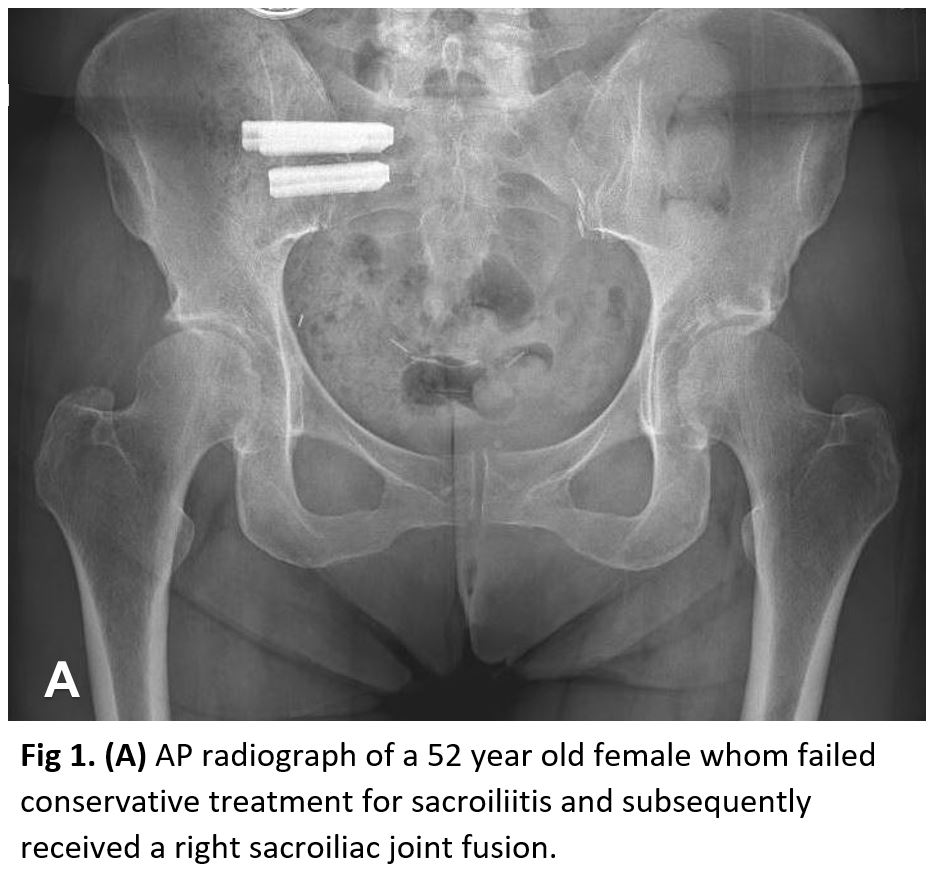[1]
Slobodin G, Hussein H, Rosner I, Eshed I. Sacroiliitis - early diagnosis is key. Journal of inflammation research. 2018:11():339-344. doi: 10.2147/JIR.S149494. Epub 2018 Sep 10
[PubMed PMID: 30237730]
[2]
Chahal BS, Kwan ALC, Dhillon SS, Olubaniyi BO, Jhiangri GS, Neilson MM, Lambert RGW. Radiation Exposure to the Sacroiliac Joint From Low-Dose CT Compared With Radiography. AJR. American journal of roentgenology. 2018 Nov:211(5):1058-1062. doi: 10.2214/AJR.18.19678. Epub 2018 Sep 12
[PubMed PMID: 30207791]
[3]
Gutierrez M, Rodriguez S, Soto-Fajardo C, Santos-Moreno P, Sandoval H, Bertolazzi C, Pineda C. Ultrasound of sacroiliac joints in spondyloarthritis: a systematic review. Rheumatology international. 2018 Oct:38(10):1791-1805. doi: 10.1007/s00296-018-4126-x. Epub 2018 Aug 11
[PubMed PMID: 30099591]
Level 1 (high-level) evidence
[4]
Kocak O, Kocak AY, Sanal B, Kulan G. Bilateral Sacroiliitis Confirmed with Magnetic Resonance Imaging during Isotretinoin Treatment: Assessment of 11 Patients and a Review of the Literature. Acta dermatovenerologica Croatica : ADC. 2017 Oct:25(3):228-233
[PubMed PMID: 29252176]
[5]
Pandita A, Madhuripan N, Hurtado RM, Dhamoon A. Back pain and oedematous Schmorl node: a diagnostic dilemma. BMJ case reports. 2017 May 22:2017():. pii: bcr-2017-219904. doi: 10.1136/bcr-2017-219904. Epub 2017 May 22
[PubMed PMID: 28536227]
Level 3 (low-level) evidence
[6]
Protopopov M, Poddubnyy D. Radiographic progression in non-radiographic axial spondyloarthritis. Expert review of clinical immunology. 2018 Jun:14(6):525-533. doi: 10.1080/1744666X.2018.1477591. Epub 2018 May 24
[PubMed PMID: 29774755]
[7]
Ziade NR. HLA B27 antigen in Middle Eastern and Arab countries: systematic review of the strength of association with axial spondyloarthritis and methodological gaps. BMC musculoskeletal disorders. 2017 Jun 29:18(1):280. doi: 10.1186/s12891-017-1639-5. Epub 2017 Jun 29
[PubMed PMID: 28662723]
Level 1 (high-level) evidence
[8]
Poddubnyy D, Listing J, Haibel H, Knüppel S, Rudwaleit M, Sieper J. Functional relevance of radiographic spinal progression in axial spondyloarthritis: results from the GErman SPondyloarthritis Inception Cohort. Rheumatology (Oxford, England). 2018 Apr 1:57(4):703-711. doi: 10.1093/rheumatology/kex475. Epub
[PubMed PMID: 29373733]
[9]
Tan S, Ward MM. Computed tomography in axial spondyloarthritis. Current opinion in rheumatology. 2018 Jul:30(4):334-339. doi: 10.1097/BOR.0000000000000507. Epub
[PubMed PMID: 29538011]
Level 3 (low-level) evidence
[10]
Žlnay M. [The role of magnetic resonance imaging in diagnostics of axial spondyloarthritis]. Vnitrni lekarstvi. 2018 Spring:64(2):117-126
[PubMed PMID: 29595277]
[11]
Expert Panel on Musculoskeletal Imaging:, Bernard SA, Kransdorf MJ, Beaman FD, Adler RS, Amini B, Appel M, Arnold E, Cassidy RC, Greenspan BS, Lee KS, Tuite MJ, Walker EA, Ward RJ, Wessell DE, Weissman BN. ACR Appropriateness Criteria(®) Chronic Back Pain Suspected Sacroiliitis-Spondyloarthropathy. Journal of the American College of Radiology : JACR. 2017 May:14(5S):S62-S70. doi: 10.1016/j.jacr.2017.01.048. Epub
[PubMed PMID: 28473095]
[12]
Nash P, Lubrano E, Cauli A, Taylor WJ, Olivieri I, Gladman DD. Updated guidelines for the management of axial disease in psoriatic arthritis. The Journal of rheumatology. 2014 Nov:41(11):2286-9. doi: 10.3899/jrheum.140877. Epub
[PubMed PMID: 25362712]
[13]
van der Heijde D,Ramiro S,Landewé R,Baraliakos X,Van den Bosch F,Sepriano A,Regel A,Ciurea A,Dagfinrud H,Dougados M,van Gaalen F,Géher P,van der Horst-Bruinsma I,Inman RD,Jongkees M,Kiltz U,Kvien TK,Machado PM,Marzo-Ortega H,Molto A,Navarro-Compàn V,Ozgocmen S,Pimentel-Santos FM,Reveille J,Rudwaleit M,Sieper J,Sampaio-Barros P,Wiek D,Braun J, 2016 update of the ASAS-EULAR management recommendations for axial spondyloarthritis. Annals of the rheumatic diseases. 2017 Jun
[PubMed PMID: 28087505]
[14]
Nelson AM, Nagpal G. Interventional Approaches to Low Back Pain. Clinical spine surgery. 2018 Jun:31(5):188-196. doi: 10.1097/BSD.0000000000000542. Epub
[PubMed PMID: 28486278]
[15]
Darr E, Meyer SC, Whang PG, Kovalsky D, Frank C, Lockstadt H, Limoni R, Redmond A, Ploska P, Oh MY, Cher D, Chowdhary A. Long-term prospective outcomes after minimally invasive trans-iliac sacroiliac joint fusion using triangular titanium implants. Medical devices (Auckland, N.Z.). 2018:11():113-121. doi: 10.2147/MDER.S160989. Epub 2018 Apr 9
[PubMed PMID: 29674852]
[16]
van Lunteren M, Ez-Zaitouni Z, de Koning A, Dagfinrud H, Ramonda R, Jacobsson L, Landewé R, van der Heijde D, van Gaalen FA. In Early Axial Spondyloarthritis, Increasing Disease Activity Is Associated with Worsening of Health-related Quality of Life over Time. The Journal of rheumatology. 2018 Jun:45(6):779-784. doi: 10.3899/jrheum.170796. Epub 2018 Mar 15
[PubMed PMID: 29545448]
Level 2 (mid-level) evidence

